Green Diamond Quality Checklist
- Color origin: Natural
- Color Grade: Fancy
- Clarity Grade: SI
- Symmetry: Good to Excellent
- Polish: Good to Excellent
- Fluorescence: None to Faint
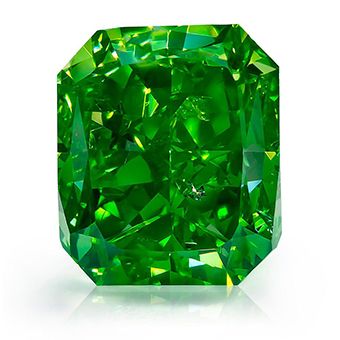
For diamonds, it’s not easy being green. Diamonds with a vivid green color, like the one shown here, are very rare. There are only about 300 examples in the world above one carat in size. Vivid green diamonds above three carats are generally only seen in museums: there are perhaps 10 known in the world.
The largest vivid green diamond that ever appeared at auction is the Aurora Green diamond, a 5.03-carat fancy vivid green diamond that sold at Christies for $16.8 million, or $3.5 million per carat.
Green diamonds are rare because the color is caused naturally by radiation deep in the earth. At some point during the billions of years when the diamonds formed or travelled to the surface in volcanic pipes they were exposed to uranium or other radioactive minerals. (Don’t worry: the diamonds themselves don’t become radioactive.) Gamma rays or particles knocked a few carbon atoms out of the diamond crystal, creating color centers that absorb red and blue light until only green remains.
Heat can excite the carbon atoms, filling those holes, so green diamonds have to be cut and polished very carefully to make sure the friction doesn't heat them up too much.
Green diamonds can also be created artificially by exposing white diamonds to radiation in a linear accelerator or a nuclear reactor. It’s very difficult for gemological laboratories to separate natural color green diamonds from treated green diamonds. An origin of color report from the Gemological Institute of America is absolutely essential when you buy a green diamond in order to confirm that the color is natural.

The most famous green diamond has been on display in the Green Vault in Dresden, Germany for more than 200 years: the Dresden Green. The largest known green diamond, the Dresden Green weighs an astonishing 41 carats.
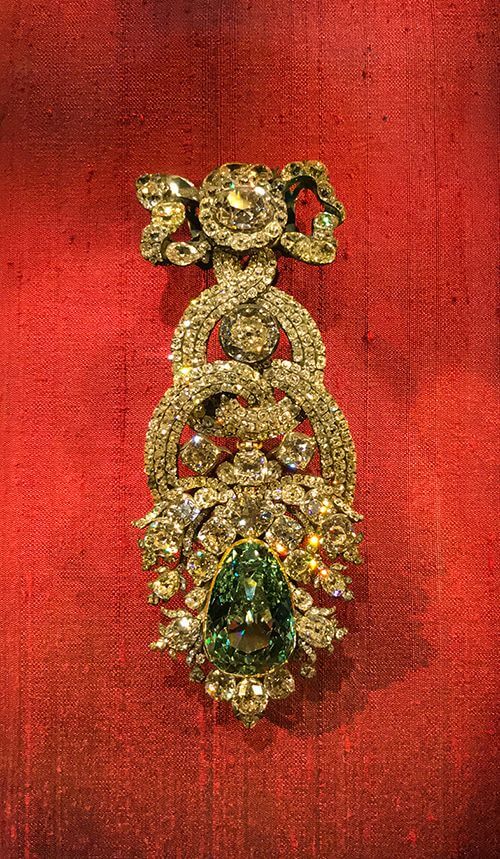
The first mention of the Dresden Green is in a London newspaper in 1722. It was purchased by Friedrich Augustus III, King of Poland in 1742 and set into a badge of the order of the Golden Fleece. In 1768, it was set into the elaborate diamond hat ornament we see today.
The Dresden Green is a natural green Type IIa diamond with a clarity grade of VS1. Some experts believe that the rough was mined at the Kollur Mine in the Indian State of Andhra Pradesh. Others believe that it was cut from rough mined in Brazil.
In addition to its long history, the Dresden Green is famous because its green color is throughout the stone, not just at the surface as is usual for natural green diamonds.
In 1988, the Dresden Green was examined by GIA research scientists to test the criteria developed to determine if a green diamond’s color is natural or treated. The Dresden Green is ideal to test the tests for natural color, since it was discovered long before irradiation experiments on diamonds began.
Sir William Crookes discovered that radiation could create the color green in diamonds in 1904, when he buried white diamonds in radioactive salts, turning them green.
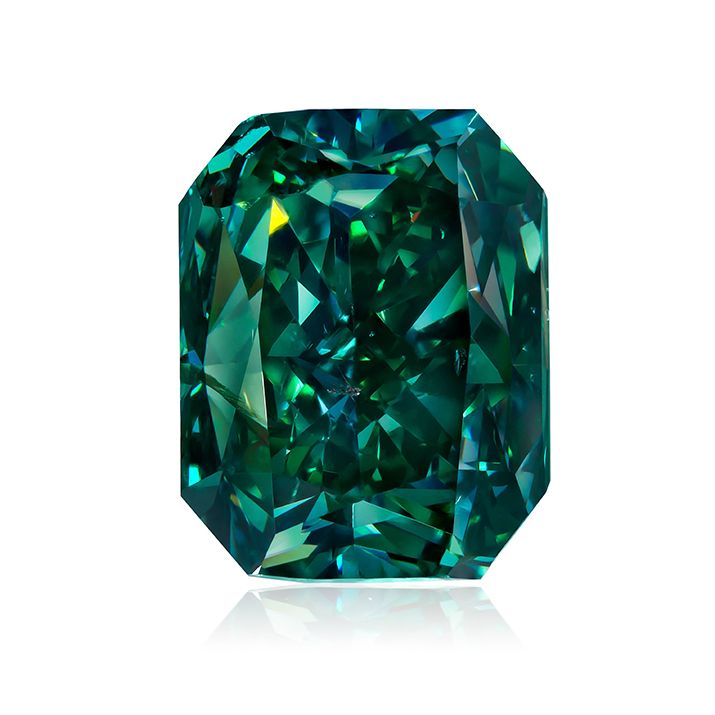
In 2018, the Natural History Museum of Los Angeles exhibited more than 60 green diamonds. The Green Diamonds: Natural Radiance exhibition featured the Mantis Diamond, the largest vivid yellowish-green diamond ever graded by the Gemological Institute of America at 4.17 carats and the Shangri-La Diamond, a large vivid green diamond weighing 3.88 carats.
The meaning of green diamonds is fertility and vitality. The color of spring, green diamonds symbolize new beginnings.
The most important quality factor for green diamonds is the saturation, or intensity, of the color. The GIA color grading scale for green diamonds begins with Faint, Very Light, and Light and then continues into the coveted fancy green colors: Fancy Light, Fancy, Fancy Intense, and Fancy Vivid. Fancy Deep or Fancy Dark may be used to describe diamonds that have a strong color but not as much saturation as Fancy Intense Green and Fancy Vivid Green diamonds. The price per carat jumps significantly between the Fancy Light and the Fancy color grades.
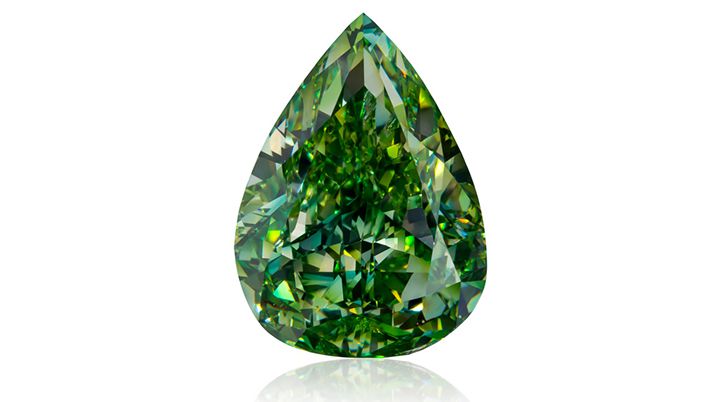
Green diamonds often have a secondary color like blue, yellow or gray. The last color mentioned on a GIA report is the dominant color. The GIA uses an adjective for the color when the secondary color is slight and a noun for the color when it is more apparent. So a yellowish green diamond is primarily green with a slight modifying tone of yellow but a yellow green diamond, although still primarily green, has a more noticeable yellow tint. Green diamonds with blue secondary colors are worth the most, followed by yellow and then gray. In the world of fancy colored diamonds, small differences in color can result in large differences in the price per carat.
Separating green diamonds with natural color from those with treated color is challenging. GIA has decades of research it uses to make the determination but it is not always possible.
Natural green diamond crystals often have green or brown radiation stains on the outside of the rough, which cannot be duplicated in a laboratory. The green color comes from the outside, usually not penetrating all the way through the crystal. In order to make identifying a genuine green diamond easier, some polishers leave an unpolished area called a “natural” on the girdle of the stone, exposing the natural color of the rough. This mark allows the gemologists analyzing the stone to confirm that the color is natural.
Treated green diamonds generally have homogenous color throughout the stone. Only in rare cases, like the Dresden Green, does a natural-color diamond have a homogenous green or bluish-green body color.
When you are considering purchasing a fancy colored diamond, it’s essential that the diamond is accompanied by a GIA Colored Diamond Grading Report. At RockHer, we never sell a fancy colored diamond without a grading report from GIA. Having a grading report from GIA confirms that a green diamond’s color is natural, that the diamond hasn’t been treated and that that the diamond is not laboratory grown. GIA has graded virtually every significant fancy colored diamond on the market: only GIA’s description of a fancy diamond’s color is trusted by the market when it comes to pricing fancy colored diamonds.
Because green diamonds are so rare and valuable, a gem with fine color may have eye visible inclusions and still be very valuable. Paler green diamonds should be eye clean or free from distracting inclusions in the center.
Unlike colorless diamonds, which are most often cut into round brilliant cuts, green diamonds are most often found in fancy shapes like oval cuts, cushion cuts, radiant cuts, pear shapes, and emerald cuts. That’s because the round brilliant cut tends to dilute the color of green diamonds. Cutters will do everything they can to enhance the color, including making the girdle thicker or the proportions deeper. That’s because color is so important to the value of the diamond it overrules all other factors.
At RockHer we specialize in setting green diamonds to maximize their impact. Contrasting a green diamond center gem with a colorless diamond halo or pink diamonds can provide contrast to set off the color of a green diamond center stone.
Green Diamond Quality Checklist
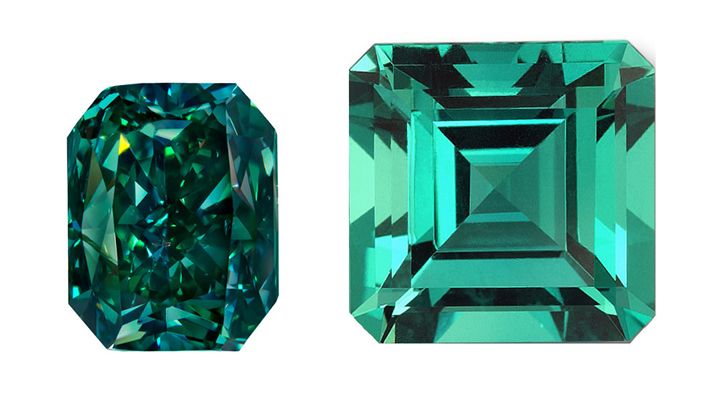
Love the look of a green diamond but don't love the price tag? At RockHer, we are big fans of emerald engagement rings. Emeralds are beautiful, rare, and much more affordable than fancy colored diamonds. And there are many more greens available, from pastel shades that mimic the look of a fancy green diamond to more intense colors that would have a million-dollar price tag if you could match them in diamond. You may find the emerald engagement ring of your dreams is more accessible than you thought it could be. Other green gem alternatives to green diamonds are demantoid garnet, tsavorite garnet, and green tourmaline. These beautiful green gems are much more affordable and available than green diamonds and more affordable than emeralds.
The style of your engagement ring setting can make your green diamond look more or less green. Even if your diamond is light green or fancy light green, you can make the color look more saturated by doing two things. First, surround the diamond with rose gold prongs or a rose gold bezel. The entire basket that holds the diamond should be rose gold if possible. Then accent the ring with bright white diamonds in while gold or platinum. The reflection from the rose gold, combined with the contrast with the white diamond in platinum or white gold, makes a paler green diamond look more intense.
The contrast effect means that halo green diamond halo engagement rings are a popular choice. Three-stone engagement rings with a green diamond center stone and white diamond side stones are another way to add contrast and make the color of your green diamond look richer.
If you are in love with green diamonds but a green diamond center stone isn’t in your budget, you can add the romance of green diamonds to your ring by adding a green diamond halo to a colorless diamond center stone. We can also add small green diamond accents to an eternity ring or wedding ring.